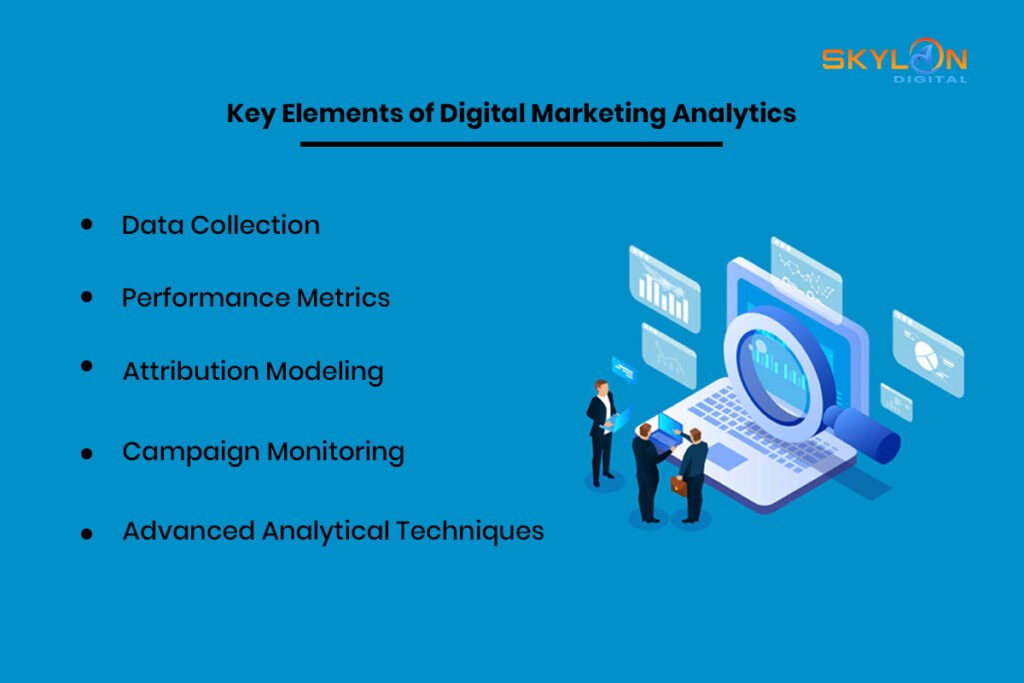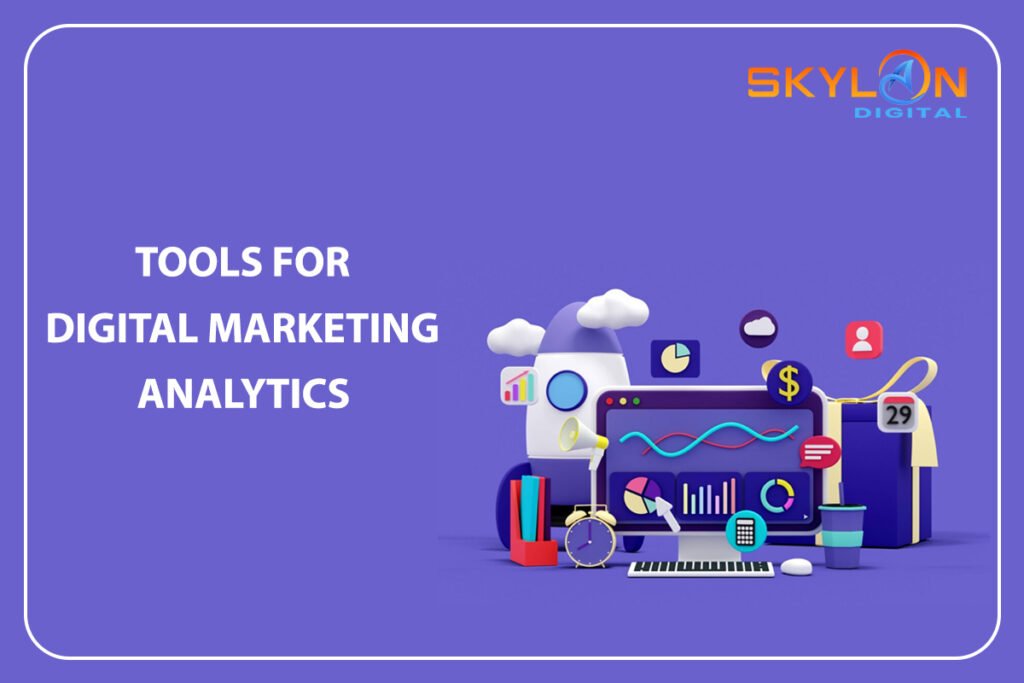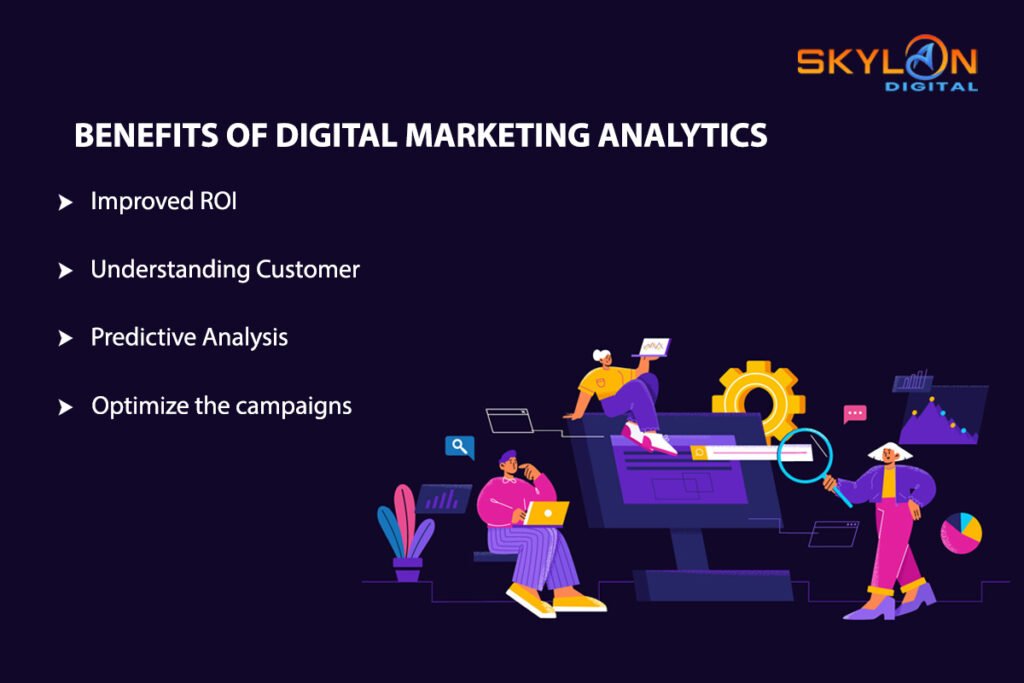
Digital Marketing Analytics is the method of collecting, measuring, analyzing, and interpreting the data and the performance from the various platforms of digital marketing efforts, including advertising campaigns, social media, email campaigns, websites and more, to enhance the decision-making and optimize strategies and generate results accordingly.
The overall goal of digital marketing analytics is to close the gap between data and decision-making so that companies can maximize the return on investment or utilize the maximum profit and strengthen their bond with their target audience.
Types of the Digital Marketing Analytics
Digital marketing analytics can be classified depending on the different analytical approaches, data sources, and campaign goals so that the businesses evaluate the performance and make decisions to increase their presence. Here is the list of the digital marketing analytics types.
Descriptive Analytics
The descriptive analytics uses the historical data of the user in reference to their products, services and more through the Website traffic, their social media engagement, including the analysis of their likes, shares, and comments, and email open and click-through rates
Diagnostic Analytics
The diagnostics analytics examines the past data or the events to understand the reasons behind the performance of the trends. That can be done with the assistance of Root cause analysis, Funnel analysis, and correlation analysis
Predictive Analytics
The use of data modeling and machine learning to evaluate the future trends and predict the upcoming outcome with the help of certain techniques, including trend prediction, sales predictions and analyzing the customer lifetime value (CLV).
Prescriptive Analytics
Based on the predictive analysis, it suggests the next step to increase the performance and presence. It can be mastered with automated decision-making, marketing automation workflows, and budget allocation model types of techniques.
Real-Time Analytics
Finding the imminent or current insight and calculating the impact of the implemented decision on focusing on the current events and trends. By applying the key metrics involving social media engagement, website visits, Ad performance metrics and more.
Behavioral Analytics
By evaluating or determining the behavior of the user with the help of the previous interaction of the data through the different mediums to optimize the user experience.
Campaign Analytics
To measure the campaign effectiveness as per the behavioral, demographical and other measures to emphasize more on the performance of the marketing campaigns. Focuses on performance analysis of specific marketing campaigns.
Competitor Analytics
To monitor the competitors performance and their presence in the market among the audiences and other competitors.
Cognitive Analytics
Cognitive analytics uses artificial intelligence (AI), machine learning (ML), and natural language processing (NLP) to reproduce the user’s prediction and analyze the complex data accordingly.
Essential Key Elements of Digital Marketing Analytics
The digital marketing Analytics involves various methods and steps to evaluate the result, manage the marketing performance on the online medium and understand the patterns, trends, and practical and useful insights. Here are the digital marketing analytics major components.
- Data Collection
- Performance Metrics
- Attribution Modeling
- Campaign Monitoring
- Advanced Analytical Techniques

Data Collection
Collecting the relevant and accurate data, both qualitative and quantitative, from the online platform to analyse the metrics and performance. There are numerous sources and tools to measure digital marketing, such as Google Analytics, SEMrush, Adobe Analytics and more.
- Google Analytics, Adobe Analytics, and other tools can be used to analyze websites.
- Similarly, analytics tools for social media platforms include LinkedIn Insights, Instagram Analytics, and others.
- The tools for analysing advertising platforms include Facebook Ads Manager, Google Ads, and others.
- The email marketing software analytics tools aid in measuring the growth and analysing other key metrics to increase the performance of the business presence and help in lead generation.
The quantitative data collected covers the page views, bounce rates, and conversion rate of the page or the website, whereas the qualitative data includes the customer feedback, reviews, and user interactions. Furthermore, the data is divided into different sectors, which include
Behavioral data
The actions, interactions, and engagement patterns of the audience or the user on digital platforms are tracked and measured by behavioural data. It displays how users interact with apps, websites, and social media sites. It covers the sections regarding the clicks, bounce rate, and scroll depth.
Transactional Data
Transactional data contains information about sales, purchases, and conversions. It covers the Purchases (Sales Data), Cart Abandonments, Order Value (AOV), Tracks the number of items returned or refunded, the average value of a completed purchase, and subscription logins.
Demographic Data
The demographic data refers to user preferences that characterize the audience. It is typically collected through surveys, account sign-ups, and Digital Marketing Analytics tools.
The demographic data focuses on numerous metrics such as age, location, or geographic Data, Language Preferences, Gender and the Income Level & Occupation (if available)
Performance Metrics
The performance metrics are measurable indicators that are used to track the performance, whereas the key performance indicators (KPIs) connect these metrics to specific business goals.
Both of the metrics are used to evaluate the growth of the company, optimize the campaigns and help in decision-making. Tracking the KPIs covers website traffic, conversion rates, click-through rates (CTR), cost-per-click (CPC), and customer acquisition cost (CAC).
Traffic Metrics
It provides an overview of the traffic on the website with respect to their demographics, referral sources and traffic sources such as social media, paid ads and more.
Engagement Metrics
Engagement metrics measure how users interact with your website, app, or content. The engagement metrics include the bounce rate, pages per Session and click-through rate (CTR), along with the social media likes, shares, and comments of the website.
Conversion Metrics
Conversion metrics evaluate how effectively marketing efforts result in planned business outcomes, such as sales, sign-ups, or subscription prediction growth. The conversion metrics measure the conversion rate, cost per acquisition (CPA), and return on ad spend (ROAS).
Attribution Modeling
The attribute modeling helps to understand which points of contact throughout the client experience drive conversions, campaign optimization and enabling better budget allocation.
The attribution modeling is classified into the mentioned sections.
Types of Attribution Models
- Single-Touch Attribution includes the First-Touch Attribution and the Last-Touch Attribution
- Multi-Touch Attribution has numerous segments as it gains multiple touch points in the customer experience journey as per the different models. The multiple model covers linear, time-decay, u-shaped (Position-Based) and the custom Attribution model.
Although while performing the attribution model, the chances of facing challenges are common and extreme as the process is complicated. Here are the number of challenges experienced in the attribution model.
Attribution model challenges
The most common attribution challenges are listed below with the solutions that can be opted to enhance the analytical performance.
- Difficulties in cross-device tracking: This condition generally occurs when the user switches devices. To manage the challenges, tools like Google Analytics 4 and similar tools that can easily track the user ID features are therefore considered ideal for the issue.
- Privacy Concerns and Data Restrictions: Issues related to the cookie restrictions, data privacy laws (GDPR, CCPA), and browser settings limit data collection. To resolve the privacy concern, shift the data toward first-party data collection, user consent management, and secure platforms.
- Offline Attribution: the in-store purchase is difficult to gather for this use the CRM system and loyalty programs.
- Data Integration Issues: the divided data from multiple platforms or sources creates inconsistent data gathering. To resolve the issue, use the data integration tools, including Google Tag Manager, Zapier, or marketing clouds like HubSpot and more.
Campaign Optimization
The campaign optimization will help to uplift the user experience, site visibility and more.
A/B Testing
Comparing two or more elements of the campaign is generally referred to as A/B testing to evaluate which has the better performance as per the key metrics. To measure the A/B testing tools such as Google Optimize, Optimize, and Mail chimp for automated A/B testing and more similar tools are used.
Real-Time Monitoring
The real-time monitoring provides immediate insights and data as per the campaign performance, enabling quick decision-making. Using dashboards and alerts to evaluate the campaigns performance. It is required to use the real-time analytics tools such as Power BI, Google Data Studio and Google Analytics to perform better for the real-time monitoring.
Heatmaps and Session Recordings
Heatmaps and session recordings provide visual insights into how users interact with a website, highlighting areas of interest and frustration.
The most common tools for the heatmaps and session recordings are Crazy Egg, Hotjar and more.
Heatmaps: Display where users click, hover, or scroll, indicating high and low engagement areas.
Advanced Analytical Techniques
- Predictive Analytics: this can be done with the help of AI and ML to anticipate the outcomes as per the historical data of the user.
- Sentiment Analysis: evaluating the outcomes with the assistance of the social media and reviewing content to determine customer sentiment.
- Cohort Analysis: this measure is calculated on the group users based on shared characteristics to analyze behavior patterns.
- Funnel Analysis: determining each stage of the conversion funnel, including awareness, interest, decision, and action.
Tools for Digital Marketing Analytics
Few tools as per the specific Digital Marketing Analytics and for calculating the overall performance of the platform or the website.

Web Analytics Tools
- Google Analytics
- Adobe Analytics
Social Media Analytics Tools
- Sprout Social
- Hootsuite
- Buffer Analytics
SEO and SEM Tools
- SEMrush
- Ahrefs
- Moz
Customer Data Platforms (CDP)
- Segment
- Salesforce CDP
Paid Campaign Analytics
- Google Ads Manager
- Facebook Ads Manager
Visualization Tools
- Google Data Studio
- Tableau
Benefits of Digital Marketing Analytics
- Improved ROI: with the help of the digital marketing analytics, the ROI of the website will be improved and can easily generate campaign revenue and focus on the performance growth.
- Understanding Customer: the digital marketing analytics helps to understand the customer’s needs, behavior and requirements and enhances the content and the products with the specifications to drive more authentic traffic with the help of feedback and other key metrics.
- Predictive Analysis: The predictive analysis factor of the digital marketing analytics assists in evaluating the future possibility of the performance growth and outcomes.

- Competitive Advantage: analyzing the marketing strategies and evaluating them with the other competitors will add an advantage in the performance upliftment of the digital platform or the website.
- Optimize the campaigns will provide the assistance to understand and refine the campaign and optimize strategy for better performance.
- Faster Decision-Making: Real-time data allows for quick adjustments to campaigns and strategies.
Process to Implement Digital Marketing Analytics
- Fix the business goals by setting the clear business goals with a calculative objective.
- Measure and identify metrics: measuring the KPIs with goals by tracking the conversion rates for lead generation campaigns and performance measures.
- Select Tools: Select the tools that fit into the budget and fulfill the business requirement.
- Data Integration: Gather the accurate data from various sources for a comprehensive view.
- Analyze and Report: evaluate the dashboards to organize and visualize the data and generate practical and useful insights.
- Expand and optimize: applying the new strategies and learning the new ways to optimize the business digitally can uplift the performance and growth of the business.
Trends in Digital Marketing Analytics
The future trends in digital marketing analytics that will help the company and the organization to evaluate the measurable insights to enhance the overall performance and the outcome of the website, business and social media on the online platform. The following are the trends that have resulted in the improvement of the business’s online image.
- AI-Powered Insights: enhancing the analytics with the help of AI tools such as ChatGPT and predictive analytics models for depth and accurate insights.
- Privacy-Centric Analytics: focuses on the first-party data and GDPR compliance.
- Analytics for Voice and Visual Search: Monitoring results in new search formats.
- Cross-Channel Attribution: with the assistance of the cross-channel attribution, it is easy to enhance the ability of the customers across the multiple devices and the channels.
FAQS
What is Digital Marketing Analytics?
In digital marketing, analytics explains the process of measuring or calculating data from various channels and platforms like websites, email, social media and more to increase the perception of customer behavior, user experience, and the impact of these factors on the business.
What is data analysis in digital marketing?
The data analytics will allow the marketers to understand the customer’s needs and behavior toward the product or service of the business with respect to their preferences and trends, so the businesses can create more personalized and niche-specified marketing strategies. The process of Digital Marketing analytics will improve the user engagement and experience and boost the effectiveness and marketing approach of the company or business.
What does a digital marketing analyst do?
The digital marketing analyst performs the research task to create the research-based strategies, enhance the SEO by applying different tactics, and evaluate promotional opportunities online.A digital marketing analyst also advises the companies or businesses about the trends and the creation and design of digital marketing plans.
What is KPI in digital marketing?
The KPI is called the key performance indicators, which are considered an important component of the digital marketing analytics and come under the diagnostic analysis. It evaluates the business performance in measurable or numerical indicators.
What are the five data analysis in Digital Marketing Analytics?
The five data analysis types in the Digital Marketing Analytics which are classified as descriptive, diagnostic, predictive, prescriptive, and cognitive analytics, which are responsible for the decision-making to increase the performance of the businesses.






